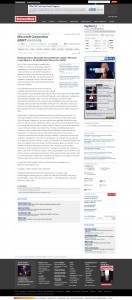May 6th, 2008 in Hindustan Times print edition
Puneet Mehrotra
There was a time when you saw a movie in a hall with a modest-sized 35 mm screen. Then the screens got larger with 70 mm. Then came stereophonic sound and surround sound and later new techniques like the Circle Vision that used nine huge screens arranged in a circle.
For the moviegoer, the increasing richness brought the experience of watching a film closer to life – and in fact, often, larger than life.
In home viewing, the CRT (cathode ray tube) has given way to LCD and Plasma TV sets, and the screens are getting flatter, larger and cheaper by the day. Home theatres are redefining the way families watch movies in the drawing room.
On the other hand broadband, Internet messaging and chat make it possible for us to share songs and videos with remote friends. Computers are getting smarter, software applications savvier and presentations richer.
What could all this lead to in a globalised world where companies work across farflung geographical locations, and yet working on common projects or for shared goals?
It leads to rich video-conference facilities that get closer to real life. Welcome to the world of Telepresence and Virtual Presence.
“The Web is a virtual space of millions of virtual places,” says an introductory note on a specialist Web site (www.virtual-presence.org). “While we are there at a virtual location, there are other people present at the same location at the same time. Virtual presence shows people who are at the same Web site at the same time…Virtual presence transfers the behaviour from the real world to the virtual space.”
Telepresence refers to a set of technologies that allow a person to feel as if he or she was present at a location other than the true location. Telepresence refers to a user interacting with another live and is distinct from virtual presence in which the user is given the impression of being in a simulated environment.
Even for individuals, virtual presence is becoming a reality. For instance, if you download the free Google Talk, it has a “chatback” badge that will let visitors to your Web page chat with you as long as you are signed in. Both telepresence and virtual presence rely on similar user-interface equipment. As a combination, they can be deadly.
Imagine a corporate world in which geography really is history. While your marketing offices maybe in the Europe or the US, the manufacturing base could be in China, and customer support or software development operations in India. Virtual presence with rich video-conferencing can change the way companies work. In fact, it is happening already on a smaller scale in many companies through audio and video conferencing and Internet chats but the scale and scope are improving dramatically.
Large video screens, electronic projectors and interactive whiteboards to help collaborative discussions while viewing common pages or documents can dramatically alter workflows. These, in industry jargon, together constitute the world of “virtual solutions.”
Industry research firm Frost & Sullivan says India’s video conferencing market in 2005-06 touched Rs.65.6 crore and is likely to grow at a compounded annual rate of about 25 per cent until 2011. Worldwide, telepresence is already a big business. Worth $64 million in 2006, it will top the $1 billion mark in 2011, according to an IDC research estimate.
Perhaps that explains the reason some of the biggest names in technology like Cisco, HP, Polycom, Microsoft and Adobe are in this field.
Like in many industries, the market is getting segregated on the basis of affordability, with differing features and quality levels.
The top-end has high-definition video, true-to-life images, surround sound and other finer details. The major players in this segment are Cisco with a service branded TelePresence, Polycom with Realpresence and HP with Halo.
Polycom’s offering resembles a science-fiction scene, complete with furnishings, studio lighting and walls, a bit like a five-star experience. Far-end meeting participants appear to be sitting just across the boardroom table. Everything is virtual including the table and the background wall and furnishings.. For this, the prize starts at $2,00,000 (Rs. 80 lakh).
Cisco’s TelePresence is similar. In the words of Cisco executive Ranajoy Punja, “Unlike video conferencing which needs an IT executive to set up the call, TelePresence can be launched at the touch of a single button. Employees can make presentations with TelePresence by plugging their laptop into the system.” The base price is $300,000 – that is Rs. 1.2 crore.
Microsoft, true to its tradition of focusing on small and medium businesses, has an affordable, stripped-down version. Microsoft’s Vibhu Ranjan says “Our product is about value.”
Compared to Cisco’s TelePresence Roundtable lacks some of the features like sensor-generated movements but it does have some really cool features. For example, it offers a video-conferencing system featuring 360° panoramic views powered by its 5 built-in cameras. Its ability to zoom in the active speaker in a meeting and its plug-and-play functionality and full integration with its Office Live Meeting software make the set-up and use simple. The affordability factor is clearly in Roundtable’s favour. It could cost as low as Rs. 2 lakh for a simple version – that is a fraction of what the big labels are offering.
Lower-end offerings constitute basic cameras attached to PC monitors. Adobe’s Brio is a Web meeting service designed for small groups. With Brio, you can instantly collaborate through an easy-to-use online personal meeting room. Three participants can attend a meeting including the host. As the host, you will need to download a small Brio add-in in order to share your screen. There is no need to schedule meetings in advance. There is no charge for the service but long-distance phone charges may apply.
Virtual presence and telepresence solutions aren’t just limited to the boardroom. For a country the size of India it may just be the next big thing to happen after the mobile boom. From healthcare to e-governance to education,virtual and telepresence can be of great help.
Imagine being able to be give your job interview without having to travel. Or being able to consult the city doctor without having to travel all the way to the city.
Telemedicine is already a reality today in certain parts of rural India. Cheaper telepresence will only hasten the process.
Puneet Mehrotra is a technology columnist
 Puneet Mehrotra
Puneet Mehrotra


